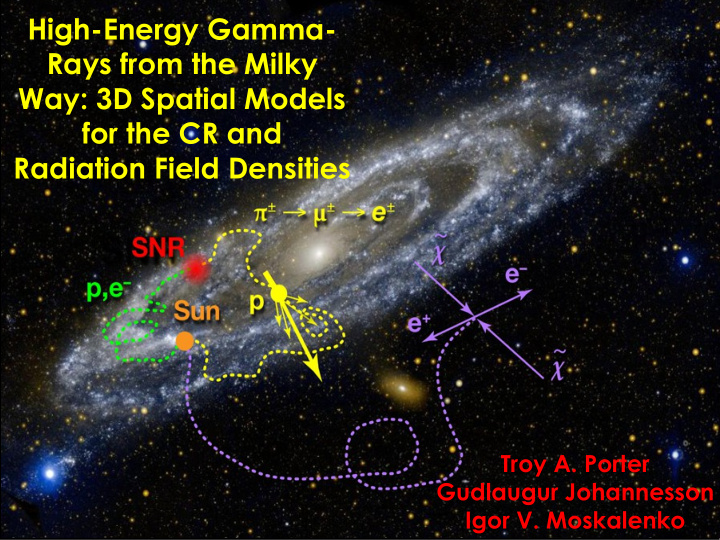



High-Energy Gamma- Rays from the Milky Way: 3D Spatial Models for the CR and Radiation Field Densities Troy A. Porter Gudlaugur Johannesson Igor V. Moskalenko
3D models for the Interstellar Emission N e w r e l e a s e o f G A L P R O P ( v 5 6 ) + 3 D C R s o u r c e d e n s i t y models + 3D ISRF models 3 CR source density models: CR power injected according to `Pulsars’ (2D), 50% Pulsars + 50% spiral arms, 100% spiral arms. Propagation parameters adjusted for each to reproduce measurements of CR data: protons, secondaries, leptons from AMS-02, PAMELA, HEAO-3 2 ISRF models: one with spiral arms, star-forming ring, central bulge; one with smooth disc with inner hole, ellipsoidal bar … both calculated with FRaNKIE code and tested to reproduce near- to far-infrared data (shorter wavelengths not so useful because of strong dust extinction). Both model inputs for the stellar luminosity and dust spatial distributions taken from literature: R12 (Robitaille et al. 2012) and F98 (Freudenreich 1998) Troy A. Porter, Stanford University ICRC 2017, Busan
Cosmic Rays Source spectra modelled with H He broken power laws in rigidity Assume diffusive reacceleration model with 6 kpc halo and fit usual propagation parameters for e - B/C each source distribution Normalisation for the propagated CR intensities is made to CR data (AMS-02, PAMELA, HEAO-3) CR energy density at plane Pulsars Troy A. Porter, Stanford University ICRC 2017, Busan
ISRF Models: R12 and F98 Intensity at Solar system Full radiation transport modelling using FRaNKIE code R12 includes stellar disc, ring, bulge, 4/2 major/minor arms + dust disc with inner hole toward GC F98 includes `old’ and `young’ stellar discs that are warped, spheroidal bar, and warped dust disc with inner hole toward GC R12 generally reproduces more structured features in the local intensity data, but both R12 and F98 ISRF models are consistent with data Troy A. Porter, Stanford University ICRC 2017, Busan
ISRF Models: R12 and F98 Energy density in plane R12 and F98 produced noticeably different integrated energy density distributions that reflect the stellar and dust distributions In and about the SED for selected X coord. inner Galaxy there is a factor ~5 difference between the models, even though locally they are both reasonably consistent with the data See contrib. 737+poster Troy A. Porter, Stanford University ICRC 2017, Busan
Interstellar Emissions Fractional Residual: [(SA100-R12) – (SA0-Std)]/[SA0-Std] SA100-R12 @ 10.6 MeV SA100-R12 @ 1.2 GeV Reference case: 2D (SA0) + Std ISRF from GALPROP Fractional residual maps [(model-ref)/ref] for other combinations: SA50-R12, SA50-F98, SA100-R12, SA100-F98 CR src and ISRF models with arms produce a density-squared effect because of enhanced CR and ISRF energy densities in these regions, produces `doughnut’ in residual maps and the effect is energy-dependent Troy A. Porter, Stanford University ICRC 2017, Busan
Troy A. Porter, Stanford University ICRC 2017, Busan
All-Sky Residuals 1-3.16 GeV Data-baseline (Pulsars) Ajello et al. `16 (no masks) Troy A. Porter, Stanford University ICRC 2017, Busan
All-Sky Residuals 1-3.16 GeV Data-baseline (Pulsars) Ajello et al. `16 (no masks) Troy A. Porter, Stanford University ICRC 2017, Busan
Intepreting the scaling results Red curves: No CR bulge Black curves: With CR bulge Dot: IC Dash: π 0 Dash-dot: Brem Solid: total This is a `what-if’ – no fits to gamma rays Troy A. Porter, Stanford University ICRC 2017, Busan
All-Sky Residuals 1-3.16 GeV Data-baseline (Pulsars) SA100/R12B-R12 Ajello et al. `16 (no masks) SA100/F98B-F98 Injected CR power for the `bulge/bar’ is ~25x smaller than the arms for the residuals shown. Increase CR power by ~50% for the bulge/bar makes the modelled residuals look more like those from the data (above). Can be done with CR nuclei/leptons or leptons only Troy A. Porter, Stanford University ICRC 2017, Busan
Summary of Fits for 15°x15° RoI Fit to data requires increase over baseline. Interpretation with 2D models unclear – ad hoc source dist, … 3D bulge/arm models provide more physical basis for understanding these results Troy A. Porter, Stanford University ICRC 2017, Busan
Summary New 3D models for ISM density distributions have been developed: ISRF (Porter et al.) and Gas (Johannesson et al.) both these proceedings Modelling with upcoming GALPROP release using 3D CR source and ISRF densities show new features in residual maps compared to 2D-based reference calculations. The 3D models provide a plausible explanation for the puzzling results from the analysis based on 2D axisymmetric models. CR sources in spiral arms and central bulge/bar in combination with 3D ISRF models are required. See also presentation by G. Johannesson (3D gas/CRs) and I. Moskalenko (GALPROP) Troy A. Porter, Stanford University ICRC 2017, Busan
Recommend
More recommend